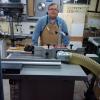I want to install a cord reel from the ceiling of my shop that is 220v. A decent medium duty 12 AWG 40ft 15A 110v will run about $170.
If you move up to a heavy duty 12 AWG 40ft 15A 110v it jumps to $320.
If you move to a heavy duty 12 AWG 40ft 20A it jumps to $370.
All of these are Reelcraft, and I am wondering if the difference from medium to heavy duty is just the recoil mechanism/case, or something else. They mention that the heavy duty are acceptable for 220v if you supply your own connectors, but don't mention 220v for the medium duty cord. They also don't say if they are UL approved if you use the heavy duty as 220v.
If a cord is a cord, is it worth an additional $150 for the heavy duty, and do you need a 20A reel, or is 15A enough to run a 5hp table saw, shaper, etc?





 Reply With Quote
Reply With Quote








